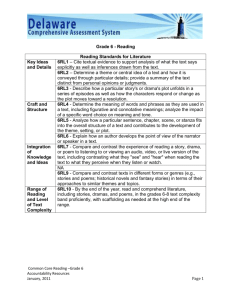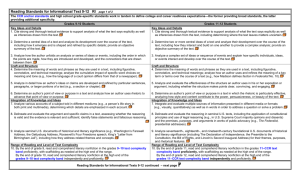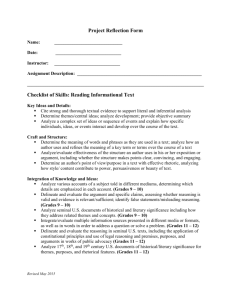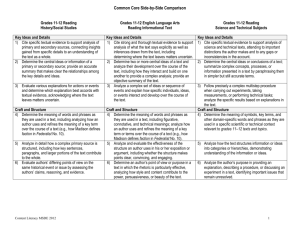3-4 to 3-8 - hannahstoneportfolio
advertisement
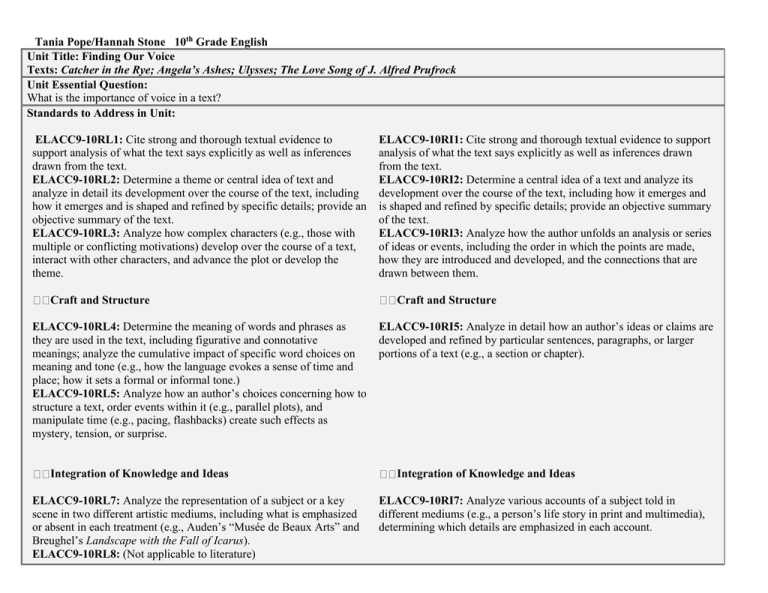
Tania Pope/Hannah Stone 10th Grade English Unit Title: Finding Our Voice Texts: Catcher in the Rye; Angela’s Ashes; Ulysses; The Love Song of J. Alfred Prufrock Unit Essential Question: What is the importance of voice in a text? Standards to Address in Unit: ELACC9-10RL1: Cite strong and thorough textual evidence to support analysis of what the text says explicitly as well as inferences drawn from the text. ELACC9-10RL2: Determine a theme or central idea of text and analyze in detail its development over the course of the text, including how it emerges and is shaped and refined by specific details; provide an objective summary of the text. ELACC9-10RL3: Analyze how complex characters (e.g., those with multiple or conflicting motivations) develop over the course of a text, interact with other characters, and advance the plot or develop the theme. Craft and Structure ELACC9-10RL4: Determine the meaning of words and phrases as they are used in the text, including figurative and connotative meanings; analyze the cumulative impact of specific word choices on meaning and tone (e.g., how the language evokes a sense of time and place; how it sets a formal or informal tone.) ELACC9-10RL5: Analyze how an author’s choices concerning how to structure a text, order events within it (e.g., parallel plots), and manipulate time (e.g., pacing, flashbacks) create such effects as mystery, tension, or surprise. Integration of Knowledge and Ideas ELACC9-10RL7: Analyze the representation of a subject or a key scene in two different artistic mediums, including what is emphasized or absent in each treatment (e.g., Auden’s “Musée de Beaux Arts” and Breughel’s Landscape with the Fall of Icarus). ELACC9-10RL8: (Not applicable to literature) ELACC9-10RI1: Cite strong and thorough textual evidence to support analysis of what the text says explicitly as well as inferences drawn from the text. ELACC9-10RI2: Determine a central idea of a text and analyze its development over the course of the text, including how it emerges and is shaped and refined by specific details; provide an objective summary of the text. ELACC9-10RI3: Analyze how the author unfolds an analysis or series of ideas or events, including the order in which the points are made, how they are introduced and developed, and the connections that are drawn between them. Craft and Structure ELACC9-10RI5: Analyze in detail how an author’s ideas or claims are developed and refined by particular sentences, paragraphs, or larger portions of a text (e.g., a section or chapter). Integration of Knowledge and Ideas ELACC9-10RI7: Analyze various accounts of a subject told in different mediums (e.g., a person’s life story in print and multimedia), determining which details are emphasized in each account. Range of Reading and Level of Text Complexity Range of Reading and Level of Text Complexity ELACC9-10RL10: By the end of grade 9, read and comprehend literature, including stories, dramas, and poems, in the grades 9-10 text complexity band proficiently, with scaffolding as needed at the high end of the range. By the end of grade 10, read and comprehend literature, including stories, dramas, and poems, in the grades 9-10 text complexity band proficiently, with scaffolding as needed at the high end of the range. ELACC9-10RI10: By the end of grade 9, read and comprehend literary nonfiction in the grades 9-10 text complexity band proficiently, with scaffolding as needed at the high end of the range. By the end of grade 10, read and comprehend literary nonfiction in the grades 9-10 text complexity band independently and proficiently. ELACC9-10W2: Write informative/explanatory texts to examine and convey complex ideas, concepts, and information clearly and accurately through the effective selection, organization, and analysis of content. a. Introduce a topic; organize complex ideas, concepts, and information to make important connections and distinctions; include formatting (e.g., headings), graphics (e.g., figures, tables), and multimedia when useful to aiding comprehension. b. Develop the topic with well-chosen, relevant, and sufficient facts, extended definitions, concrete details, quotations, or other information and examples appropriate to the audience’s knowledge of the topic. c. Use appropriate and varied transitions to link the major sections of the text, create cohesion, and clarify the relationships among complex ideas and concepts. d. Use precise language and domain-specific vocabulary to manage the complexity of the topic. e. Establish and maintain a formal style and objective tone while attending to the norms and conventions of the discipline in which they are writing. f. Provide a concluding statement or section that follows from and supports the information or explanation presented (e.g., articulating implications or the significance of the topic). Comprehension and Collaboration ELACC9-10SL1: Initiate and participate effectively in a range of collaborative discussions(one-on-one, in groups, and teacher-led) with diverse partners on grades 9–10 topics, texts, and issues, building on others’ ideas and expressing their own clearly and persuasively. a. Come to discussions prepared, having read and researched material under study; explicitly draw on that preparation by referring to evidence from texts and other research on the topic or issue to stimulate a thoughtful, well-reasoned exchange of ideas. b. Work with peers to set rules for collegial discussions and decision-making (e.g., informal consensus, taking votes on key issues, presentation of alternate views), clear goals and deadlines, and individual roles as needed. c. Propel conversations by posing and responding to questions that relate the current discussion to broader themes or larger ideas; actively incorporate others into the discussion; and clarify, verify, or challenge ideas and conclusions. d. Respond thoughtfully to diverse perspectives, summarize points of agreement and disagreement, and, when warranted, qualify or justify their own views and understanding and make new connections in light of the evidence and reasoning presented. ELACC9-10SL2: Integrate multiple sources of information presented in diverse media or formats (e.g., visually, quantitatively, orally) evaluating the credibility and accuracy of each source. Presentation of Knowledge and Ideas ELACC9-10SL4: Present information, findings, and supporting evidence clearly, concisely, and logically such that listeners can follow the line of reasoning and the organization, development, substance, and style are appropriate to purpose, audience, and task. ELACC9-10SL5: Make strategic use of digital media (e.g., textual, graphical, audio, visual, and interactive elements) in presentations to enhance understanding of findings, reasoning, and evidence and to add interest. ELACC9-10L1: Demonstrate command of the conventions of standard English grammar and usage when writing or speaking. a. Use parallel structure.* b. Use various types of phrases (noun, verb, adjectival, adverbial, participial, prepositional, absolute) and clauses (independent, dependent; noun, relative, adverbial) to convey specific meanings and add variety and interest to writing or presentations. ELACC9-10L2: Demonstrate command of the conventions of standard English capitalization, punctuation, and spelling when writing. a. Use a semicolon (and perhaps a conjunctive adverb) to link two or more closely related independent clauses. b. Use a colon to introduce a list or quotation. c. Spell correctly. Knowledge of Language ELACC9-10L3: Apply knowledge of language to understand how language functions in different contexts, to make effective choices for meaning or style, and to comprehend more fully when reading or listening. a. Write and edit work so that it conforms to the guidelines in a style manual (e.g., MLA Handbook, Turabian’s Manual for Writers) appropriate for the discipli ELACC9-10L4: Determine or clarify the meaning of unknown and multiple-meaning words and phrases based on grades 9–10 reading and content, choosing flexibly from a range of strategies. a. Use context (e.g., the overall meaning of a sentence, paragraph, or text; a word’s position or function in a sentence) as a clue to the meaning of a word or phrase. c. Consult general and specialized reference materials (e.g., dictionaries, glossaries, thesauruses), both print and digital, to find the pronunciation of a word or determine or clarify its precise meaning, its part of speech, or its etymology. d. Verify the preliminary determination of the meaning of a word or phrase (e.g., by checking the inferred meaning in context or in a dictionary). ELACC9-10L5: Demonstrate understanding of figurative language, word relationships, and nuances in word meanings. a. Interpret figures of speech (e.g., euphemism, oxymoron) in context and analyze their role in the text. b. Analyze nuances in the meaning of words with similar denotations. ELACC9-10L6: Acquire and use accurately general academic and domain-specific words and phrases, sufficient for reading, writing, speaking, and listening at the college and career readiness level; demonstrate independence in gathering vocabulary knowledge when considering a word or phrase important to comprehension or expression. ASSESSMENTS Diagnostic: Formative: Summative: Group work, class discussion, writer’s Reading quizzes, timed writing essay workshop ON-GOING ROUTINE: Grammar practice MONDAY 1/7 TUESDAY 1/8 WEDNESDAY 1/9 THURSDAY 1/10 FRIDAY 1/11 Daily Outline & Essential Question ELACC9-10W3: Write narratives to develop real or imagined experiences or events using effective technique, well-chosen details, and wellstructured event sequences ELACC9-10RI6: Determine an author’s point of view or purpose in a text and analyze how an author uses rhetoric to advance that point of view or purpose. ELACC9-10W3: Write narratives to develop real or imagined experiences or events using effective technique, well-chosen details, and wellstructured event sequences ELACC9-10RI6: Determine an author’s point of view or purpose in a text and analyze how an author uses rhetoric to advance that point of view or purpose. ELACC9-10W3: Write narratives to develop real or imagined experiences or events using effective technique, well-chosen details, and well-structured event sequences ELACC9-10RI6: Determine an author’s point of view or purpose in a text and analyze how an author uses rhetoric to advance that point of view or purpose. What is voice? What purpose does voice serve in writing? How can we develop our own voices? How is McCourt’s voice evident? What is stream of consciousness? How can we identify stream of consciousness writing? How is The Catcher in the Rye written in stream of consciousness? What is an unreliable narrator? How do we see Holden acting as an unreliable narrator? How can we identify an unreliable narrator in other formats? OPENING Getting students ready to learn WORK PERIOD Releasing students to do the work CLOSING Helping students make sense of their learning Voice (30) Grammar (10) Read chapter 1 (20) Read chapter 2 (20) Reading quiz (10) Advisement (60) Unreliable narrator (30) Assign chapters 3 and 4 for homework Unreliable narrator journal (15) Stream of consciousness (20) Who are you? (10) Stream of consciousness journal (10) Assign chapters 5 and 6 for homework Sherlock Holmes (60)

